Mulinane and Azorellane Diterpenoid Biomarkers by GC-MS from a Representative Apiaceae (Umbelliferae) Species of the Andes
Abstract
:1. Introduction
2. Results and Discussion
2.1. Diterpenoid Hydrocarbons
2.2. Oxygenated Diterpenoids
3. Samples and Experimental Methods
4. Conclusions
Supplementary Materials
Author Contributions
Funding
Acknowledgments
Conflicts of Interest
Appendix A
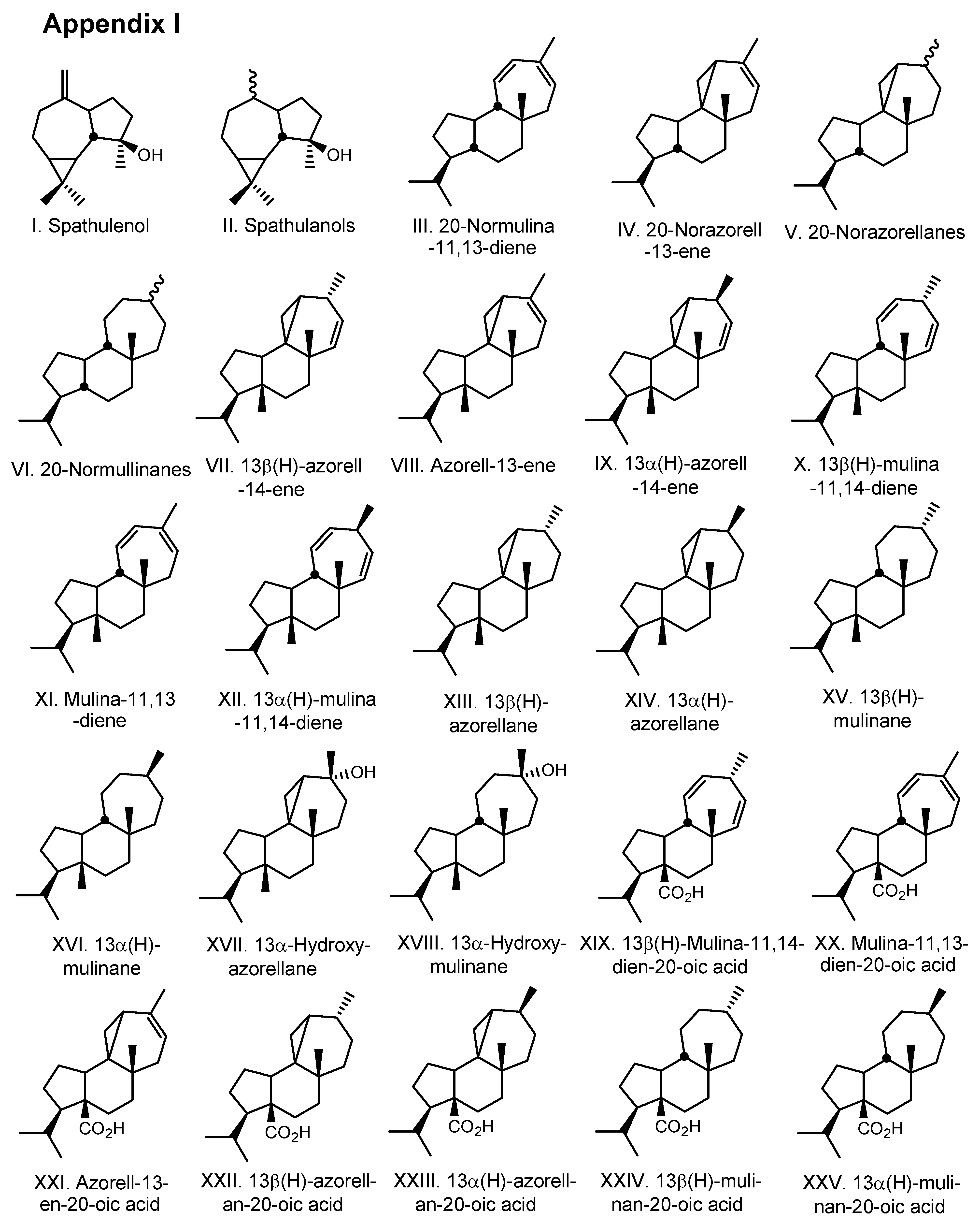
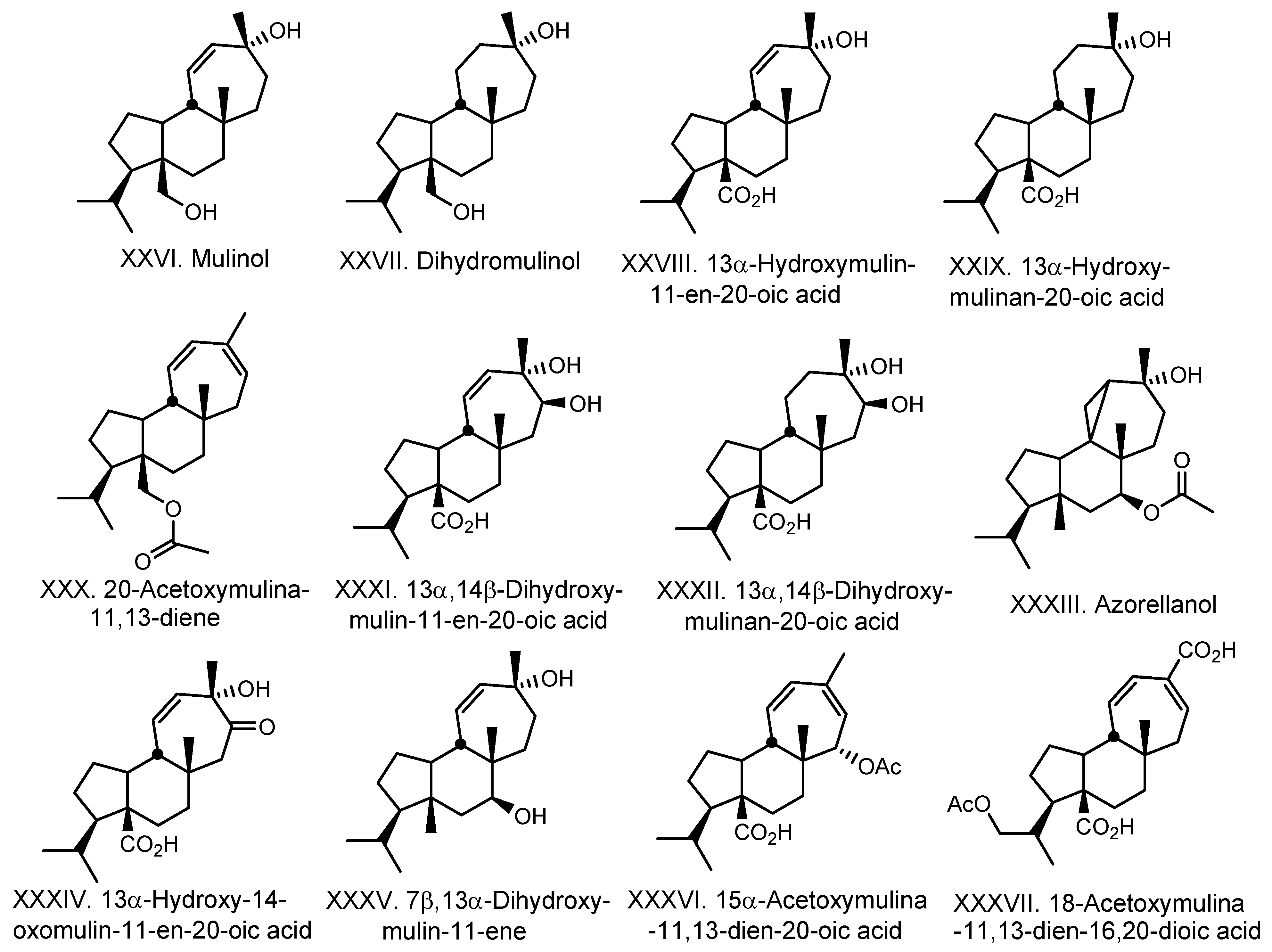
References
- Johns, R.B. Biological Markers in the Sedimentary Record; Elsevier: Amsterdam, The Netherlands, 1986; p. 364. [Google Scholar]
- Simoneit, B.R.T. The organic chemistry of marine sediments. In Chemical Oceanography, 2nd ed.; Riley, J.P., Chester, R., Eds.; Academic Press: New York, NY, USA, 1978; Volume 7, pp. 233–311. [Google Scholar]
- Simoneit, B.R.T. Organic matter of the troposphere-V: Application of molecular marker analysis to biogenic emissions into the troposphere for source reconciliations. J. Atmos. Chem. 1989, 8, 251–275. [Google Scholar] [CrossRef]
- Simoneit, B.R.T. A review of biomarker compounds as source indicators and tracers for air pollution. Environ. Sci. Pollut. Res. 1999, 6, 153–163. [Google Scholar] [CrossRef] [PubMed]
- Simoneit, B.R.T.; Mazurek, M.A. Organic matter of the troposphere-II: Natural background of biogenic lipid matter in aerosols over the rural western United States. Atmos. Environ. 1982, 16, 2139–2159. [Google Scholar] [CrossRef]
- Otto, A.; White, J.D.; Simoneit, B.R.T. Natural product terpenoids in Eocene and Miocene conifer fossils. Science 2002, 297, 1543–1545. [Google Scholar] [CrossRef] [PubMed]
- Medeiros, P.M.; Simoneit, B.R.T. Multi-biomarker characterization of sedimentary organic carbon in small rivers draining the northwestern United States. Org. Geochem. 2008, 39, 52–74. [Google Scholar] [CrossRef]
- Simoneit, B.R.T.; Halpern, H.I.; Didyk, B.M. Lipid productivity of a high Andean lake. In Biogeochemistry of Ancient and Modern Environments; Trudinger, P.A., Walter, M.R., Ralph, B.J., Eds.; Australian Academy of Sciences: Canberra, Australia, 1980; pp. 201–210. [Google Scholar]
- Muñoz, C. Sinopsis de la Flora Chilena, 2nd ed.; Edition de la Universidad de Chile: Santiago, Chile, 1966; p. 500. [Google Scholar]
- Simoneit, B.R.T.; Didyk, B.M. The lipid and resin composition of Laretia compacta Phil. from the Andes of Chile. Z. Naturforsch. C 1999, 54, 309–313. [Google Scholar] [CrossRef]
- Nicolas, A.N.; Plunkett, G.M. Untangling generic limits in Azorella, Laretia, and Mulinum (Apiaceae: Azorelloideae): Insights from phylogenetics and biogeography. Taxon 2012, 61, 826–840. [Google Scholar] [CrossRef]
- Creceau-Larrival, M.-T. Morphologie pollinique et corrélation phytogénétique chez les Ombelifères. In The Biology and Chemistry of the Umbelliferae; Heywood, V.H., Ed.; Academic Press: London, UK, 1971; pp. 109–135. [Google Scholar]
- Saldivia, P.; Faundez, L.; Urbina-Casanova, R.; Scherson, R.A. Demeykoa andina (Apiaceae; Azorelloideae), a new species from northern Chile. Syst. Bot. 2016, 41, 457–463. [Google Scholar] [CrossRef]
- Suárez Contreras, I. Contribución al estudio Botánico y Químico de le Laretia compacta Phil. (Llareta); Facultad de Biología y Ciencias Médicas, Universidad de Chile: Santiago, Chile, 1935. [Google Scholar]
- Wickens, G.E. Llareta (Azorella compacta, Umbelliferae): A review. Econ. Bot. 1995, 49, 207–212. [Google Scholar] [CrossRef]
- Loyola, L.A.; Morales, G.; Rodríguez, B.; Jiménez-Barbero, J.; de la Torre, M.C.; Perales, A.; Torres, M.R. Mulinic and isomulinic acids, rearranged diterpenes with a new carbon skeleton from Mulinum crassifolium. Tetrahedron 1990, 46, 5413–5420. [Google Scholar] [CrossRef]
- Loyola, L.A.; Morales, G.; de la Torre, M.C.; Pedreros, S.; Rodríguez, B. 17-Acetoxymulinic acid, a rearranged diterpenoid from Mulinum crassifolium. Phytochemistry 1990, 29, 3950–3951. [Google Scholar] [CrossRef]
- Loyola, L.A.; Morales, G.; Rodríguez, B.; Jiménez-Barbero, J.; Pedreros, S.; de la Torre, M.C.; Perales, A. Mulinenic acid a rearranged diterpenoid from Mulinum crassifolium. J. Nat. Prod. 1991, 54, 1404–1408. [Google Scholar] [CrossRef]
- Loyola, L.A.; Bórquez, J.; Morales, G.; San-Martín, A. Diterpenoids from Azorella compacta. Phytochemistry 1997, 44, 649–651. [Google Scholar] [CrossRef]
- Loyola, L.A.; Bórquez, J.; Morales, G.; San-Martín, A. Mulinol, a diterpenoid from Azorella compacta. Phytochemistry 1997, 45, 1465–1467. [Google Scholar] [CrossRef]
- Loyola, L.A.; Bórquez, J.; Morales, G.; San-Martín, A.; Manríquez, V.; Wittke, O. Azorellanol: A diterpenoid with a new carbon skeleton from Azorella compacta. Tetrahedron 1998, 54, 15533–15540. [Google Scholar] [CrossRef]
- Loyola, L.A.; Bórquez, J.; Morales, G.; San-Martín, A. 11,12-Epoxy-mulin-13-en-20-oic acid, a diterpenoid from Azorella compacta. Phytochemistry 1998, 49, 1091–1093. [Google Scholar] [CrossRef]
- Loyola, L.A.; Bórquez, J.; Morales, G.; Araya, J.; González, J.; Neira, I.; Sagua, H.; San-Martín, A. Diterpenoids from Azorella yareta and their trichomonicidal activities. Phytochemistry 2001, 56, 177–180. [Google Scholar] [CrossRef]
- Loyola, L.A.; Bórquez, J.; Morales, G.; San-Martín, A.; Darias, J. Madreporanone, a unique diterpene with a novel skeleton from Azorella madreporica. Tetrahedr. Lett. 2002, 43, 6359–6362. [Google Scholar] [CrossRef]
- Loyola, L.A.; Bórquez, J.; Morales, G.; San-Martín, A.; Manríquez, V.; Boys, D.; Darias, J. Yaretol, a norditerpenoid from Azorella madreporica. J. Nat. Prod. 2002, 65, 1678–1680. [Google Scholar] [CrossRef]
- Loyola, L.A.; Bórquez, J.; Morales, G.; San-Martín, A.; Darias, J.; Flores, N.; Giménez, A. Mulinane-type diterpenoids from Azorella compacta display antiplasmodial activity. Phytochemistry 2004, 65, 1931–1935. [Google Scholar] [CrossRef]
- Nicoletti, M.; di Fabio, A.; d’Andrea, A.; Salvatore, G.; van Baren, C.; Coussio, J.D. Diterpenoid acids from Mulinum spinosum. Phytochemistry 1996, 43, 1065–1067. [Google Scholar] [CrossRef]
- Wächter, G.A.; Matooq, G.; Hoffmann, J.J.; Maiese, W.M.; Singh, M.P.; Montenegro, G.; Timmermann, B.N. Antibacterial diterpenoid acids from Azorella compacta. J. Nat. Prod. 1999, 62, 1319–1321. [Google Scholar] [CrossRef] [PubMed]
- Areche, C.; Rojas-Alvarez, F.; Campos-Briones, C.; Lima, C.; Pérez, E.G.; Sepúlveda, B. Further mulinane diterpenoids from Azorella compacta. J. Pharm. Pharmacol. 2013, 65, 1231–1238. [Google Scholar] [CrossRef] [PubMed]
- Areche, C.; Sepúlveda, B.; San-Martín, A.; García-Beltrán, O.; Simirgiotis, M.; Cañete, A. An unusual mulinane diterpenoid from the Chilean plant Azorella compacta (Gaertn) Pers. Org. Biomol. Chem. 2014, 12, 6406–6413. [Google Scholar] [CrossRef] [PubMed]
- Bórquez, J.; Ardiles, A.; Loyola, L.A.; Peña-Rodriguez, L.M.; Molina-Salinas, G.M.; Vallejos, J.; Collado, I.G.; Simirgiotis, M.J. Further mulinane and azorellane diterpenoids isolated from Mulinum crassifolium and Azorella compacta. Molecules 2014, 19, 3898–3908. [Google Scholar] [CrossRef] [PubMed]
- Bórquez, J.; Bartolucci, N.L.; Echiburú-Chau, C.; Winterhalter, P.; Vallejos, J.; Jerz, G.; Simirgiotis, M.J. Isolation of cytotoxic diterpenoids from the Chilean medicinal plant Azorella compacta Phil from the Atacama Desert by high-speed counter-current chromatography. J. Sci. Food Agric. 2015, 96, 2832–2838. [Google Scholar] [CrossRef] [PubMed]
- Salgado, F.; Areche, C.; Sepúlveda, B.; Simirgiotis, M.J.; Caceres, F.; Quispe, C.; Quispe, L.; Cano, T. A new mulinane diterpenoid from the cushion shrub Azorella compacta growing in Peru. Pharmacog. Mag. 2014, 10, S542–S548. [Google Scholar] [CrossRef]
- Sepúlveda, B.; Quispe, C.; Simirgiotis, M.; García-Beltrán, O.; Areche, C. Gastroprotective effects of new diterpenoid derivatives from Azorella cuatrecasasii Mathias & Constance obtained using a β-cyclodextrin complex with microbial and chemical transformations. Bioorg. Med. Chem. Lett. 2016, 26, 3220–3222. [Google Scholar]
- San-Martín, A.; Bacho, M.; Núñez, S.; Rovirosa, J.; Soler, A.; Blanc, V.; León, R.; Olea, A.F. A novel normulinane isolated from Azorella compacta and assessment of its antibacterial activity. J. Chil. Chem. Soc. 2018, 63, 4082–4085. [Google Scholar] [CrossRef]
- Liu, Y.-T.; Li, L.-P.; Xie, J.-H.; Zhou, Q.-L. Divergent asymmetric total synthesis of mulinane diterpenoids. Angew. Chem. Int. Edit. 2017, 56, 12708–12711. [Google Scholar] [CrossRef]
- Reber, K.P.; Xu, J.; Guerrero, C.A. Synthesis of mulinane diterpenoids. J. Org. Chem. 2015, 80, 2397–2406. [Google Scholar] [CrossRef]
- Noble, R.A.; Alexander, R.; Kagi, R.I.; Knox, J. Tetracyclic diterpenoid hydrocarbons in some Australian coals, sediments and crude oils. Geochim. Cosmochim. Acta 1985, 49, 2141–2147. [Google Scholar] [CrossRef]
- Noble, R.A.; Alexander, R.; Kagi, R.I.; Knox, J. Identification of some diterpenoid hydrocarbons in petroleum. Org. Geochem. 1986, 10, 825–829. [Google Scholar] [CrossRef]
- Shareef, A.; Angrove, M.J.; Wells, J.D. Optimization of silylation using N-methyl-N-(trimethylsilyl)-trifluoroacetamide, N,O-bis-(trimethylsilyl)-trifluoroacetamide and N-(tert-butyldimethylsilyl)-N-methyltrifluoroactamide for the determination of the estrogens estrone and 17α-ethinylestradiol by gas chromatography-mass spectrometry. J. Chromatogr. A 2006, 1108, 121–128. [Google Scholar] [PubMed]
- Kühnel, E.; Laffan, D.D.P.; Lloyd-Jones, G.C.; Martínez del Campo, T.; Shepperson, I.R.; Slaughter, J.L. Mechanism of methyl esterification of carboxylic acids by trimethylsilyldiazomethane. Angew. Chem. Int. Ed. 2007, 46, 7075–7078. [Google Scholar] [CrossRef] [PubMed]
- Kovats, E. Gas-chromatographische Charakterisierung organischer Verbindungen. Teil 1: Retentionsindices aliphatischer Halogenide, Alkohole, Aldehyde und Ketone. Helv. Chim. Acta 1958, 41, 1915–1932. [Google Scholar] [CrossRef]
Sample Availability: Not available. |
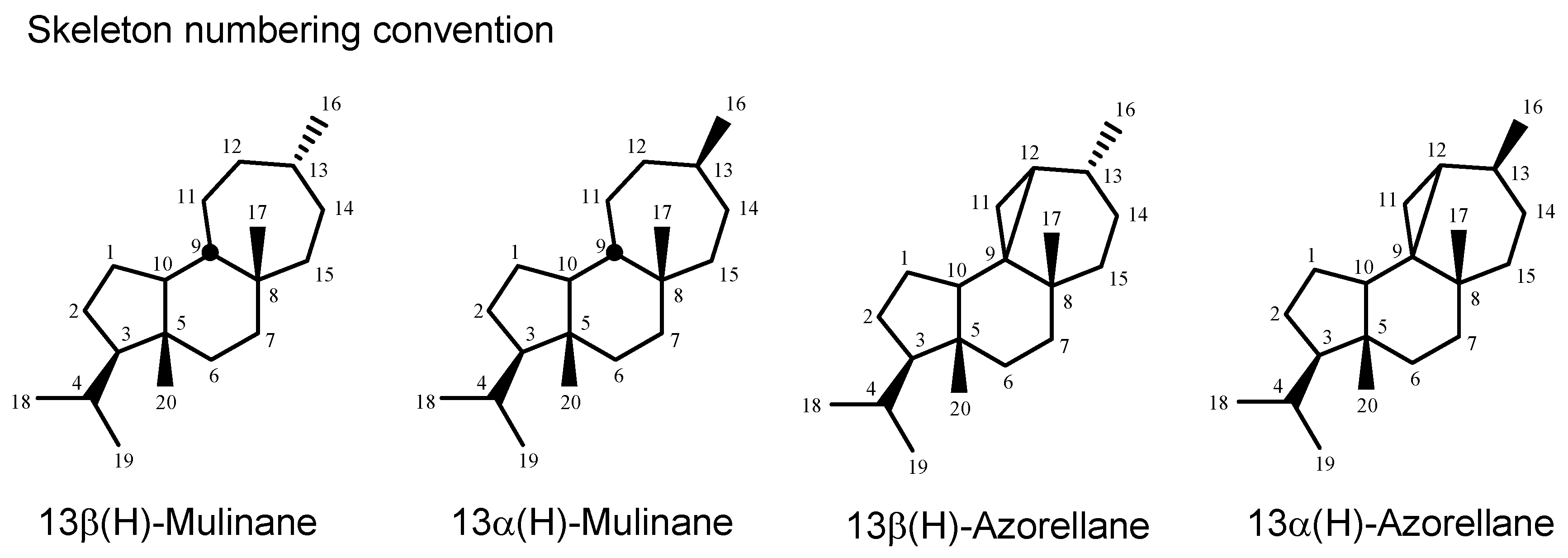
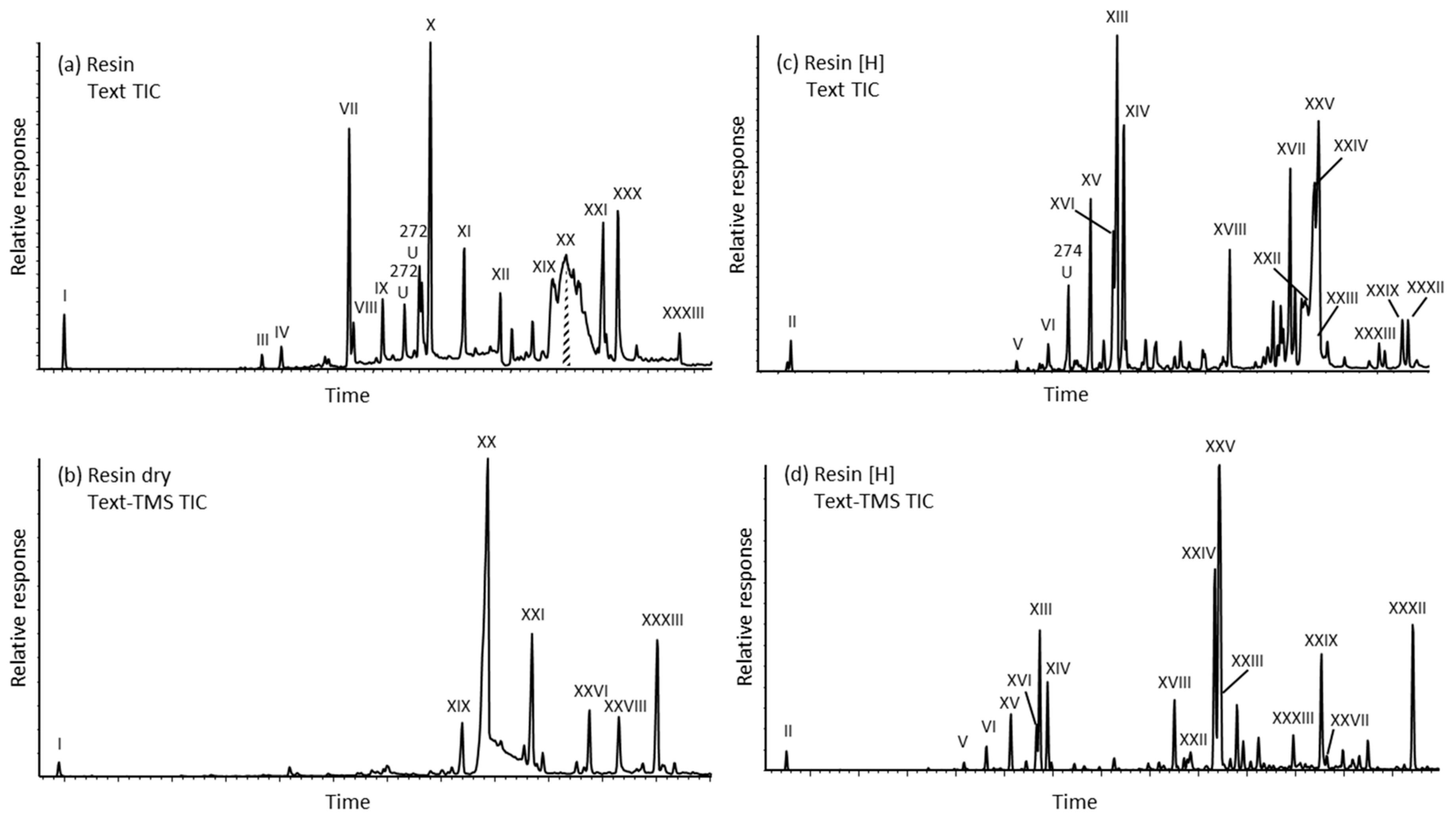
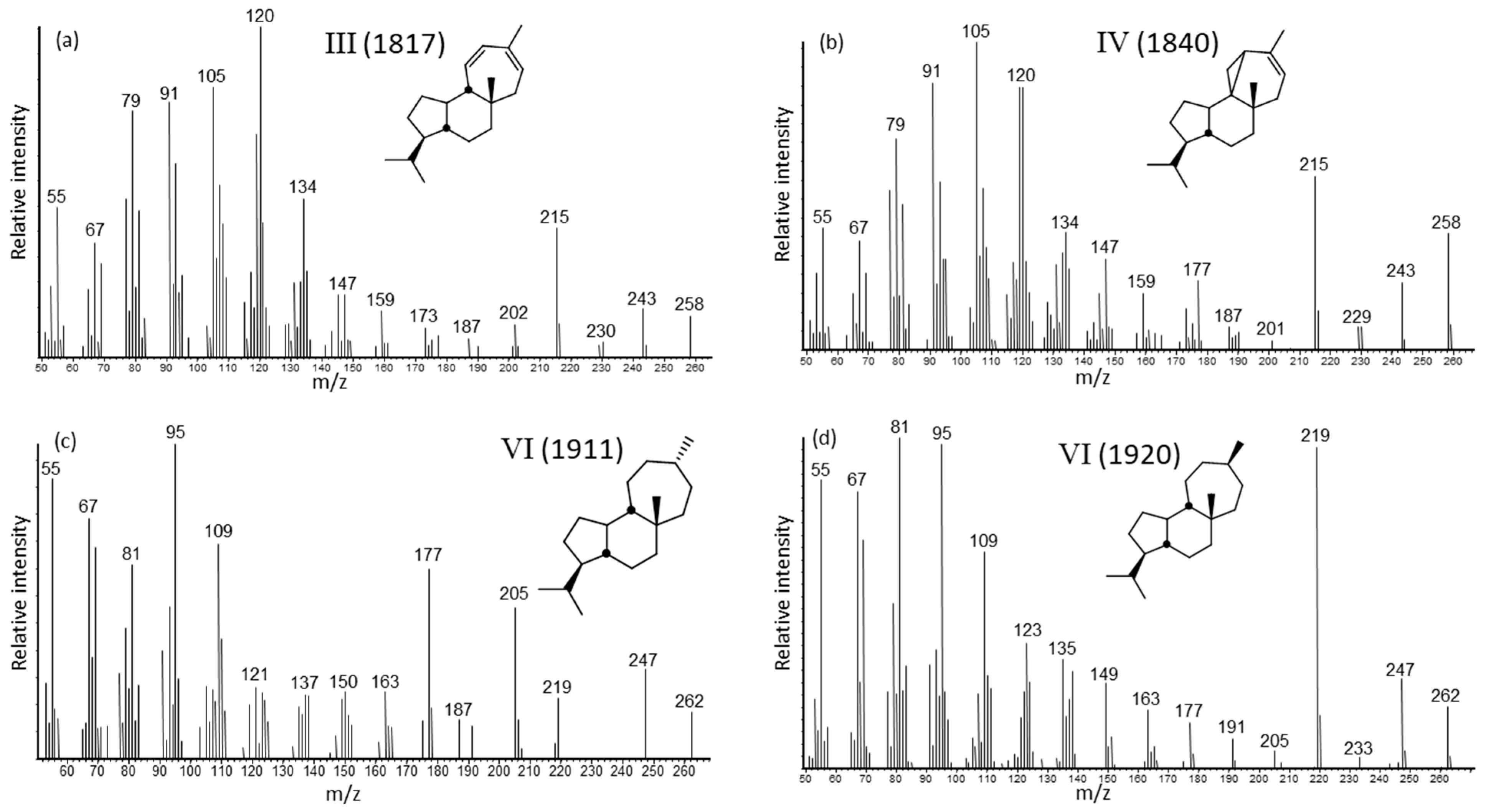
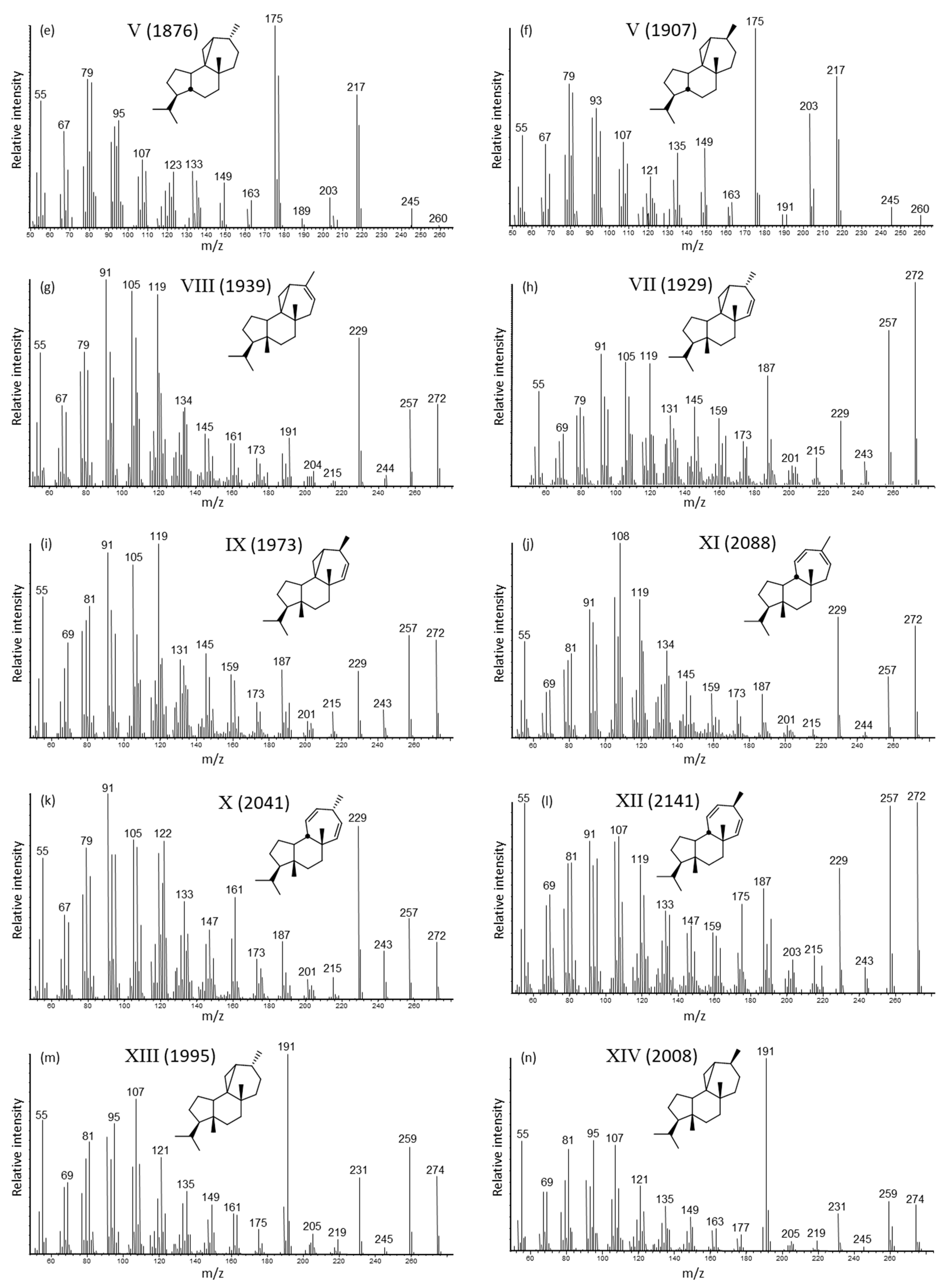

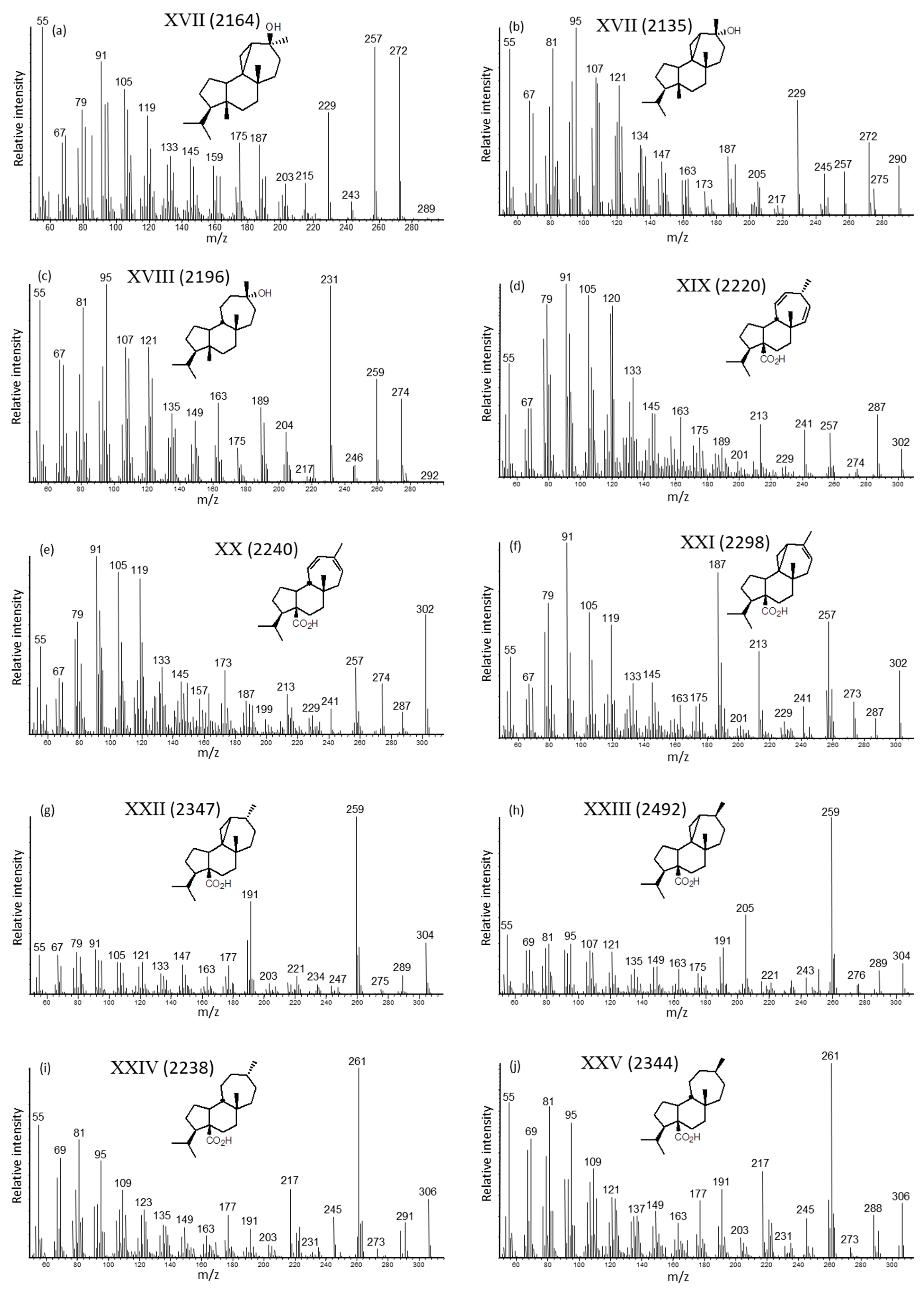
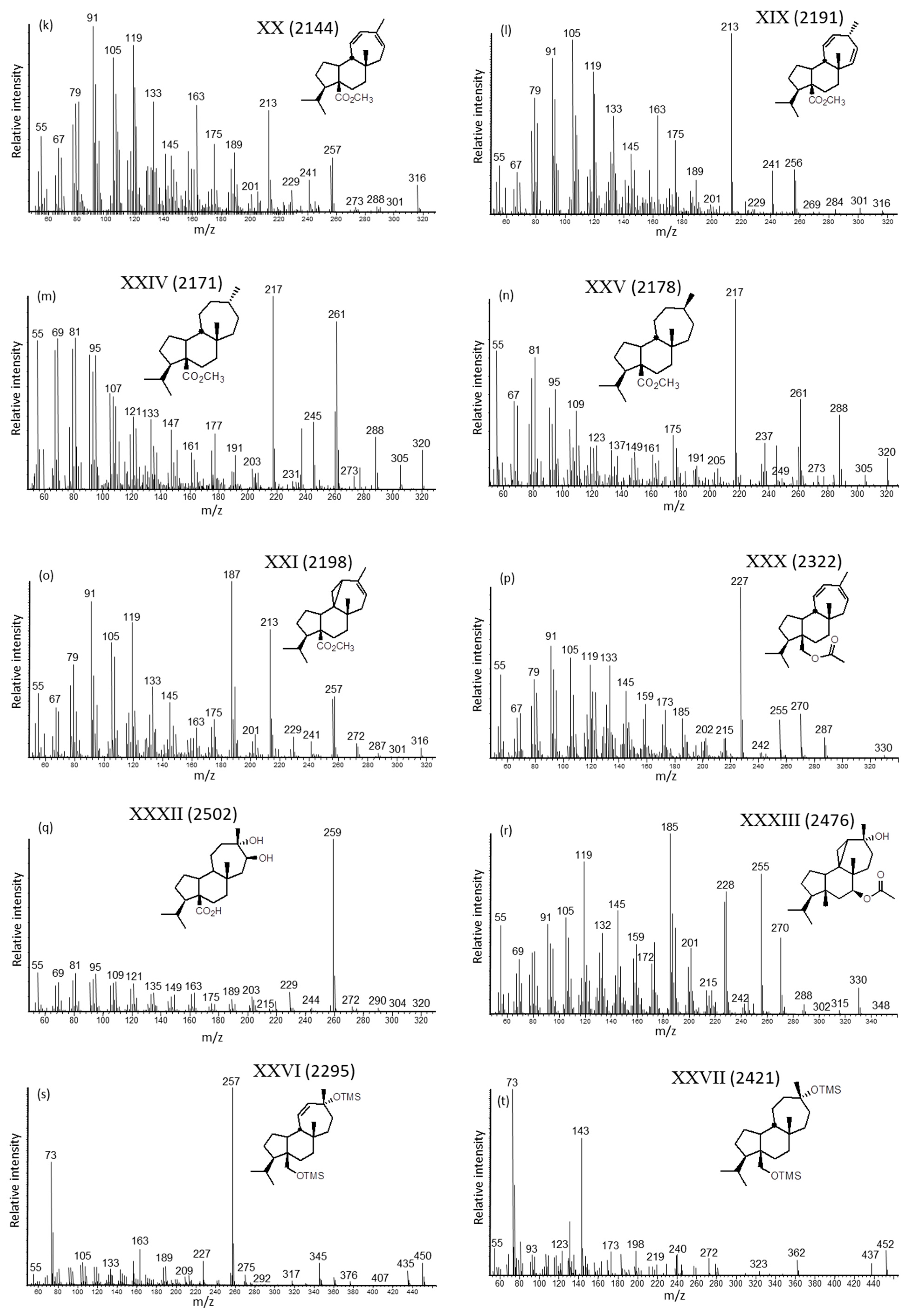
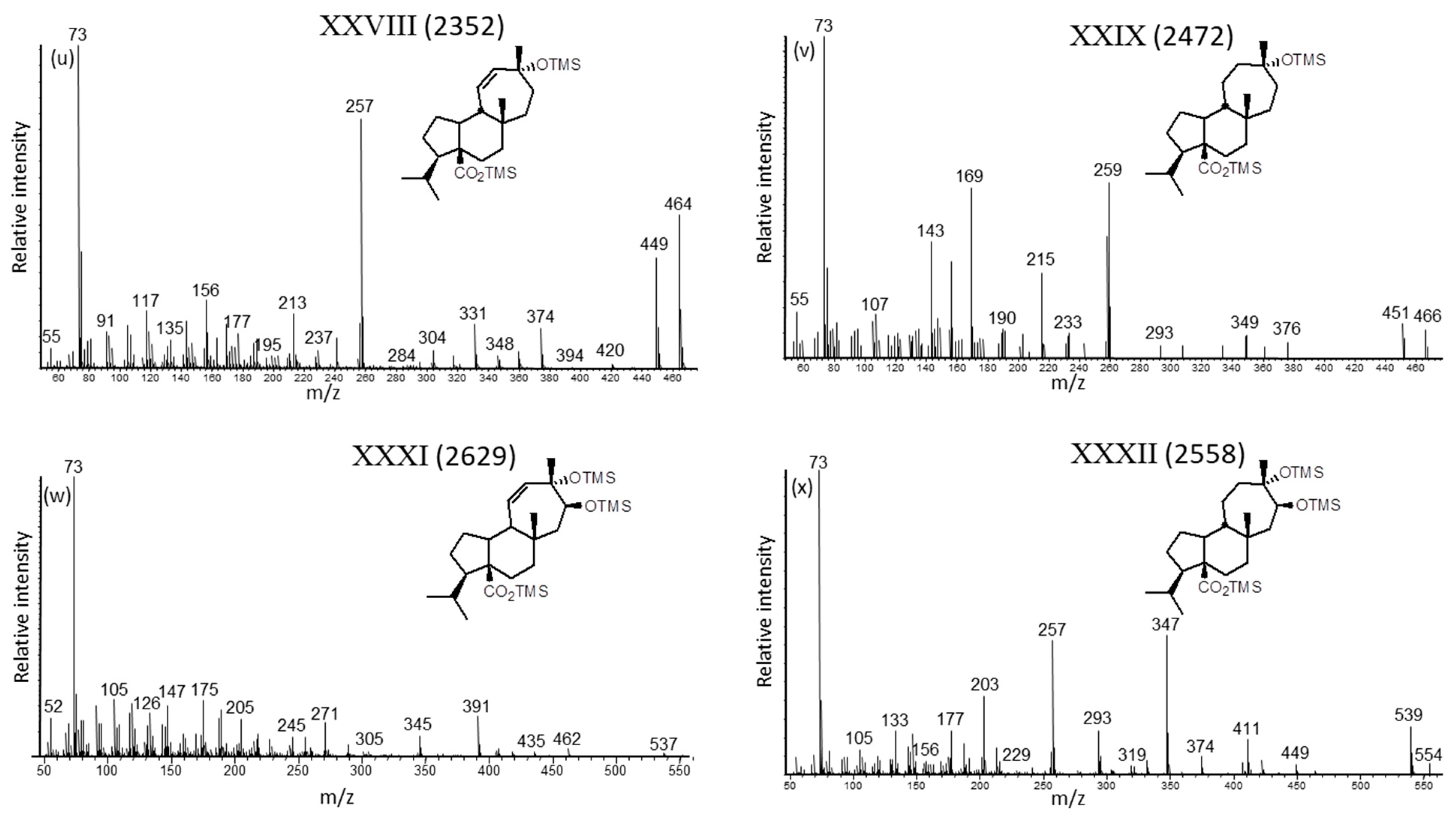
| Structure Number a | Compound | Composition b | MW | ID c | Resin (n = 7) | Hydrogenated Resin (n = 4) |
|---|---|---|---|---|---|---|
| I | Spathulenol | C15H24O | 220 | S | 1.4 | |
| II | Spathulanol | C15H26O | 222 | S | 3 | |
| III | 20-Normulina-11,13-diene | C19H30 | 258 | T | 0.5 | |
| IV | 20-Norazorell-13-ene | C19H30 | 258 | T | 1 | |
| V | 20-Norazorellane, α + β | C19H32 | 260 | T | 1 | |
| VI | 20-Normulinane, α + β | C19H34 | 262 | T | 0.3 | |
| VII | 13β(H)-Azorell-14-ene | C20H32 | 272 | T | 9 | |
| VIII | Azorell-13-ene | C20H32 | 272 | I | 2 | |
| IX | 13α(H)-Azorell-14-ene | C20H32 | 272 | T | 2.5 | |
| X | 13β(H)-Mulina-11,14-diene | C20H32 | 272 | I | 16 | |
| XI | Mulina-11,13-diene | C20H32 | 272 | L | 7 | |
| XII | 13α(H)-Mulina-11,14-diene | C20H32 | 272 | I | 4 | |
| XIII | 13β(H)-Azorellane | C20H34 | 274 | I | 26 | |
| XIV | 13α(H)-Azorellane | C20H34 | 274 | I | 15 | |
| XV | 13β(H)-Mulinane | C20H36 | 276 | I | 11 | |
| XVI | 13α(H)-Mulinane | C20H36 | 276 | I | 8 | |
| XVII | 13-Hydroxyazorellanes | C20H34O | 290 | L | 14 | |
| XVIII | 13α-Hydroxymulinane | C20H36O | 292 | L | 22 | |
| XIX | 13β(H)-Mulina-11,14-dien-20-oic acid | C20H30O2 | 302 | S | 10 | |
| XX | Mulina-11,13-dien-20-oic acid | C20H30O2 | 302 | S | 100 | |
| XXI | Azorell-13-en-20-oic acid | C20H30O2 | 302 | S | 17 | |
| XXII | 13β(H)-Azorellan-20-oic acid | C20H32O2 | 304 | S | 5 | |
| XXIII | 13α(H)-Azorellan-20-oic acid | C20H32O2 | 304 | S | 30 | |
| XXIV | 13β(H)-Mulinan-20-oic acid | C20H34O2 | 306 | S | 44 | |
| XXV | 13α(H)-Mulinan-20-oic acid | C20H34O2 | 306 | S | 100 | |
| XXVI | Mulinol | C20H34O2 | 306 | L | 7 | |
| XXVII | Dihydromulinol | C20H36O2 | 308 | I | 6 | |
| XXVIII | 13α-Hydroxymulin-11-en-20-oic acid | C20H32O3 | 320 | S | 8 | |
| XXIX | 13α-Hydroxymulinan-20-oic acid | C20H34O3 | 322 | S | 25 | |
| XXX | 20-Acetoxymulina-11,13-diene | C22H34O2 | 330 | L | 15 | |
| XXXI | 13α,14β-Dihydroxymulin-11-en-20-oic acid | C20H30O4 | 336 | L | 11 | |
| XXXII | 13α,14β-Dihydroxymulinan-20-oic acid | C20H34O4 | 338 | I | 32 | |
| XXXIII | Azorellanol | C22H36O3 | 348 | L | 16 | 12 |
© 2019 by the authors. Licensee MDPI, Basel, Switzerland. This article is an open access article distributed under the terms and conditions of the Creative Commons Attribution (CC BY) license (http://creativecommons.org/licenses/by/4.0/).
Share and Cite
Simoneit, B.R.T.; Oros, D.R.; Jaffé, R.; Didyk-Peña, A.; Areche, C.; Sepúlveda, B.; Didyk, B.M. Mulinane and Azorellane Diterpenoid Biomarkers by GC-MS from a Representative Apiaceae (Umbelliferae) Species of the Andes. Molecules 2019, 24, 684. https://doi.org/10.3390/molecules24040684
Simoneit BRT, Oros DR, Jaffé R, Didyk-Peña A, Areche C, Sepúlveda B, Didyk BM. Mulinane and Azorellane Diterpenoid Biomarkers by GC-MS from a Representative Apiaceae (Umbelliferae) Species of the Andes. Molecules. 2019; 24(4):684. https://doi.org/10.3390/molecules24040684
Chicago/Turabian StyleSimoneit, Bernd R.T., Daniel R. Oros, Rudolf Jaffé, Alexandra Didyk-Peña, Carlos Areche, Beatriz Sepúlveda, and Borys M. Didyk. 2019. "Mulinane and Azorellane Diterpenoid Biomarkers by GC-MS from a Representative Apiaceae (Umbelliferae) Species of the Andes" Molecules 24, no. 4: 684. https://doi.org/10.3390/molecules24040684
APA StyleSimoneit, B. R. T., Oros, D. R., Jaffé, R., Didyk-Peña, A., Areche, C., Sepúlveda, B., & Didyk, B. M. (2019). Mulinane and Azorellane Diterpenoid Biomarkers by GC-MS from a Representative Apiaceae (Umbelliferae) Species of the Andes. Molecules, 24(4), 684. https://doi.org/10.3390/molecules24040684







